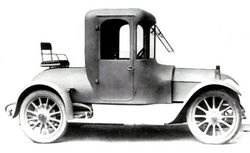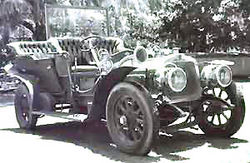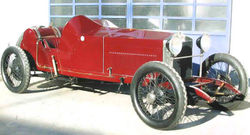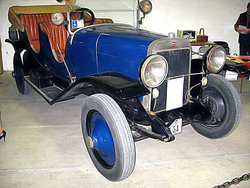Diatto

The 'Diatto-Clement Societa Anonima' was born in 1905 from an accord between Diatto (a Turin based company since 1835) and Clement (a Paris based company) in order to construct cars known as the 'Torino' at Turin. These were actually licenced products from the latter company.The first car was the 20-25HP which used a 3770cc four cylinder engine, followed the year after by the 10-12HP (1884cc two-cylinder) and the 14-18HP (2724cc four-cylinder). The success of these models led to more being introduced, including a six-cylinder model.
In 1909 Clement left the business and the company was renamed 'Societa Fonderie Officine Frejus'. The first real Diatto design appeared shortly afterwards, the 16/20. Production proceeded at around 250 to 300 cars per year. During the first world war new models continued to be introduced (the 18HP, 20-25HP and 30-40HP) as well as chassis' for light commercial vehicles for the military. Diatto 30 (1925)An expansion program led to the purchase of various companies in and around Turin (including Scacchi, the builder of the Storero brand cars and Newton, builder of cars badged NB) whose experience, equipment and plans were all used by Diatto. A bodyshop was also founded for the internal production of the bodies.
After a brief name change in 1918, in 1919 the company became 'Societa Anonima Automobili Diatto'. Financial problems followed the war, but cars continued to be developed and produced. The Tipo 10 was a small car with a 1018cc four-cylinder engine, whilst the Tipo 30 was built under licence from Bugatti and included a four-valve-per-cylinder 1452cc four cylinder engine (later increased to 2-litres) with around 30bhp.
Following liquidation in 1923 a new company was formed in 1924 with new investors. The Tipo 20 family (20, 20A and 20S) was released, and a Grand Prix car was developed using a supercharged 2-litre dohc eight cylinder powerplant. Interestingly this car was originally designed by Giuseppe Coda and developed further by Alfieri Maserati. The economic situation at the time was, however, not to be denied another victim and in 1928 the last cars were produced. The company continued to produce some spare parts and components until the 1950s when it was totally absorbed into 'S.p.A. G. Veglio & C.'.

1922 Targa Florio

The "Diatto 20s" who came to drive in the 1 April 1922 Targa Florio, with 3 cars, the No. 15 driven by Guido Meregalli, No. 16 entrusted to Domenico Gamboni and No. 17 drivin by Massola, but all three cars did not finish the grueling race.
The Diatto's flew along streets fabulously, bringing the number of chassis 20069th en ° Engine 20066. Massola unfortunately did not finish the race, like the other two races with drivers Diatto Meregalli and Gambon.
Technical characteristics of the Diatto 20S 1922-1925
- Engine - 4 cylinder inline engine capacity 1995, Max 45CV to 2,700 rpm, overhead valves, a cam shaft in the head, Solex carburetor, water cooling.
- Transmission - Rear-wheel drive shaft drive gear Spiral, clutch disc single
4 speed gear + RG
- Brakes - Front and rear drum with foot pedal, lever on the transmission.
- Steering - Worm and Wheel ecoidale.
- Suspension - Front axle with semi-elliptical leaf springs, post. Cantilever with crossbow
- Wheels - Rims removable Rudge Whitworth 820x120
- Dimension and weight - Track 1.420mm, 3.100mm pitch, bare weight 900Kg.
- Performance - Maximum speed 95 km/h
The Diatto is a trademark Torinese still alive. In fact, the "International Diatto Lda" located in Portugal, with the expressed purpose of achieving a historical log of about 200 cars still exist.
Diatto Ottovù Zagato 2007
On 09 February, 2007, Zagato released a press docket detailing its revival of the Diatto marque, to celebrate its 100th anniversary, with the unveiling of a new all-aluminum sports car, called the Diatto Ottovù Zagato, during the 77th Geneva Motor Show this March 2007. Zagato has since released Official Photos of the upcoming vehicle as of 13 February, 2007.
The Diatto Ottovù Zagato is an upcoming sports car designed and built by Milanese coachbuilder Carrozzeria Zagato for two of its clients. Coinciding with the 100th anniversary of the Diatto brand, the car made its official public debut at the 2007 Geneva Motor Show.
Back in 1921, Ugo Zagato designed a lightweight and aerodynamic body for the Diatto 25 4DS chassis. Created in 1835 with a Perfected Wheel patent, Diatto made their first car in 1905 and often crossed paths with Zagato in their close collaboration with Ettore Bugatti, the Maserati brothers and Tazio Nuvolari.
The word "Ottovù" incidentally means "V8" in Italian. A clear indication of the engine powering this vehicle and show of the car's sporting intent.
==Chronology== (Source))
One hundred and twenty years of Diatto history, from 1835, when Guglielmo Diatto (son of Biagio), started a wheelwright’s business on the banks of the river Po, in Turin, until 1955, when the company was taken over by Veglio & C. SpA. Over a century of intense work, with ups and downs, making a fundamental contribution to the history of motor racing. This page meticulously sets out the events which shaped the family’s decisions and the history of the automobile manufacturer, giving the reader an overall picture of the period and the business.
===Company Chronology=== (Source))
1814 10 June: death of Biagio Diatto in Carmagnola.
1835 Guglielmo Diatto, Biagio’s son, opens a wheel-wrights workshop on the banks of the river Po, Turin, leasing the land from Count Francesco Gay.
1861 5 May: Guglielmo Diatto buys the land from Count Gay and extends the laboratory, to a design by Architect Giuseppe Brocchi.
1862 8 October: further extensions based on plans drawn up by Saverio Avenati (Engineer).
1863 Further extensions based on plans by Architect Luigi Formento.
1864 16 October: death of Guglielmo Diatto. The business passes to his sons, Vincenzo, Giovanni, Giovanni Battista and Pietro, with shares going to the widow, Anna, and daughters Teresa, Angela, Giuseppa and Rosa.
1865 The new company, Guglielmo Diatto Eredi, (heirs of Guglielmo Diatto) enlarges the manufacturing facilities. The plans are by Luigi Formento.
1867 31 January: the female side of the family makes over shares to the male heirs.
1868 1st September: the company takes the name Fratelli Diatto and further enlarges the premises to plans drawn up by Architect Giuseppe Brocchi.
1874 12 November: Diatto Brothers builds new production facilities.
1875 17 February: a new factory wing is built to plans by Architect Luigi Formento.
1878 9 May: the Priest Giuseppe Delfino sells a house, garden and meadow to Fratelli Diatto (Diatto Brothers) for Itl 20,000. 23 October: Leone Bauquel sells land and a newly built house to Giovanni, Giovanni Battista and Pietro Diatto for Itl 9,500. The property is close to Borgo di Po.
1879 16 May: Carlo Marinetti and his wife Lucia Cerutti sell a strip of land on the banks of the Po to Fratelli Diatto.
1880 10 August: death of Vincenzo Diatto, unmarried. He leaves his part of the company to his mother, brothers and sisters.
1881 Carlo and Lucia Marinetti sell a strip of land in Borgo di Po to the brothers Giovanni, Giovanni Battista and Pietro Diatto.
1882 22 May: the Priest Giuseppe Delfino sells a house, orchard and meadow to Fratelli Diatto for Itl 55,000. The property is located in Rubatto area. 11 July: Lucia and Carlo Marinetti sell the company a piece of land in Borgo di Po for the construction of a new factory, for Itl 4,587.
1884 14 September: death of Pietro Diatto, who leaves his property and assets to his four children Guglielmo, Ferdinando, Ettore and Rosa, and to his widow Giuseppina Arduino. The premises and land in Borgo di Po is allocated to Giovanni and Giovanni Battista Diatto.
1885 26 June: Fratelli Diatto builds a new floor in the premises situated at number 10, corso Moncalieri, to plans drawn up by Silvio Secchieri, head of the Technical Dept. and former student of the Fine Arts at the Venice Academy.
1887 15 February: Pietro’s children and wife sell assets to Giovanni and Giovanni Battista Diatto, for Itl 500,000. The assets include the premises in Borgo di Po, at numbers 8, 10, 14 and 28, consisting of a large farmhouse and a number of industrial facilities with land. The property is between the streets named after Moncalieri, Bauquel, Autino and Alzaia, in the direction of river Po and Gioannetti.
1889 17 July: the family Lucia and Carlo Marinetti sell the remaining property in Borgo di Po to the company. It is situated in Rubatto area, at via Collino, number 13, bordering on the company’s property to the west and with the city and navigable river Po to the east. 23 July: Giovanni and Giovanni Battista Diatto wind up the company. They divide up the assets, consisting of industrial premises, buildings and land with houses in Borgo di Po, via Moncalieri, numbers 8, 10, 14 and from 16 to 28, on 6,059 acres. Giovanni Battista pays his brother Itl 590,000 for his share of the business.
1897 18 June: Giovanni Battista Diatto demolishes and rebuilds the premises of the company on the banks of the river Po.
1899 4 March: Fratelli Diatto becomes Società Anonima Officine già Fratelli Diatto. Initial capital share Itl 3,600,000. The Company Chairman is Giovanni Battista Diatto, Managing Director Vittorio Guyot, Technical Director Engineer Dante Ferraris, Diatto’s son-in-law. On the same day Giovanni Battista Diatto sold the premises and land to the company Società Anonima Officine già Fratelli Diatto for Itl 1,145,000. 30 December: the family Curtino-Castagneri sells the company 16 acres of land for Itl 104,000. The land is located outside Orbassano, and is part of the Rosa alla Crocetta farmland between the Milan and Susa railway lines.
1901 8 January: the Curtino-Castagneri family sell Società Anonima Officine già Fratelli Diatto the farmland outside Orbassano.
1907 9 July: Paolo Palestrino and Luigi Simondetti sell the company Società Anonima Officine già Fratelli Diatto 9.6 acres of land (part of the Grangia estate, between properties owned by Itala) for Itl 192,272.80.
1908 15 February: the Curtino-Castagneri family sell 2.5 acres of land between the Itala premises and Bealera Cassola to the company. The cost is Itl 5,603.55.
1909 27 October: the ramp from via Moncalieri to the Umberto I bridge is declared a work of public interest. The Turin City Authority places a compulsory purchase order on the factory owned by Società Anonima Officine già Fratelli Diatto, for a value of Itl 64,929.01.
1912 At the age of 70, Giovanni Battista Diatto retires, leaving his son-in-law and Chairman of Fiat San Giorgio Costruzioni Navali e Meccaniche, Engineer Dante Ferraris, to run the company. He continued to live in Turin, maintaining his homes in via Barbaroux 2, and in Saint Vincent, via Porta Romana 79. 14 June: the Managing Directors of Itala, Edoardo Pavesio and Guido Bigio, sold properties and land to the company Società Anonima Officine già Fratelli Diatto for Itl 9,361.65. The land is situated outside Orbassano, between corso Racconigi, Diatto properties and Bealera Cossola.
1918 23 April: Società Anonima Officine già Fratelli Diatto, the railway supplies manufacturer, merges with Fiat the first Italian manifacturer in this field - a deal worth Itl 4,669,491.50 and involving the sale of the premises in Orbassano and corso Moncalieri, Turin.
1920 25 May: at the age of 83, Giovanni Diatto dies in Turin, at his home in piazza Gran Madre di Dio, 12.
1922 20 July: Giovanni Battista Diatto dies in Saint Vincent. He is buried in the family tomb in Turin.
In 1905, the first generation owners had encouraged Vittorio and Pietro, Guglielmo’grandsons and sons of Giovanni Battista Diatto, to become auto manufacturers, thus beginning the history of a famous manufacturer and racing car team.
===Chronology of the Cars=== (Source))
1905 12 April: Società Automobili Diatto-A. Clément is incorporated by Vittorio and Pietro Diatto-Fonderie Officine Meccaniche Costruzioni in Ferro and Société des Établissements Adolphe Clément-Automobiles Bajard with headquarters in Levallois Perret (Paris), for the manufacturer in Turin of automobiles under Clément license. The Company Chairman is Adolphe Clément, Deputy Chairman and Managing Director Engineer Vittorio Diatto. Share capital is Itl 1,500,000, of which Itl 450,000 is paid up. The duration of the company is established until 30 September 1935. Company headquarters is in via Fréjus 21. The factory was built between the streets named after Fréjus, Cesana and Moretta, on land covering 25,000 square meters. 90 HP of power is installed, supplied by 3 three-phase motors powering about 200 machine tools. Nearly 500 workers are employed in the factory.
1906 At the Turin Exhibition, the company presents the Diatto-Clément Turin 8/10 HP, 10/12 HP, 12/16 HP and 20/24 HP. In September the workshop is enlarged to meet demand for the new models. 22 December: the AGM with Board of Auditors headed by Vittorio Gujot, and with Engineer Andrea Gonella and attorney Giuliano Capponi Trenca.
1907 New models include the 2-cylinder Diatto-Clément Turin 10/12 HP and 4-cylinder 14/18 HP, 20/25 HP, 25/35 HP. The factory produces around 250 cars a year.
1908 A continuation of the previous year’s models with a new 6-cylinder 24 HP model.
1909 The extraordinary General Meeting on 30 June decides to cut all links with the French auto manufacturerm and partner. Clément makes over 7,000 shares in the company with a value of Itl 350,000. The shares are destroyed. The share capital goes from Itl 1,500,000 to Itl 1,150,000. The new name of the company is Fonderie Officine Fréjus which uses exclusively the oval Diatto logo on a red background. Vittorio Diatto remains as Managing Director. A new model is introduced, the 4-cylinder monoblock 15/20 HP.
1910 A new -cylinder monoblock 12/15 HP is produced, derived from the 15/20 HP manufactured in 1909. General dealer for Lazio is Fornari & Muletti, via Aureliana 14-16-18, Rome.
1911 The 16 HP Unique Type is launched.
1912 The 18 HP Uniqye Type goes into production. Dealers in Piedmont: Paschetta and G. Ambrosini, both based in Turin.
1913 The 18 HP Unique Type continues to be produced.
1914 The Unique Type is manufactured under the name 16/20 HP.
1915 Work on the new premises in via Moretta 55 is terminated. The new facility is a body shop. 1st April: the premises in via Moncalieri 15 - the original site of the wheelwright business started in 1835 by Guglielmo Diatto - are sold to Bertorelli, Cerruti & C. In December, the company buys the John Newton factories (formerly Valt) in Turin, and the factories of
Scacchi in Chivasso, moving all the equipemnt and machinery to via Fréjus. Production of the 18/20 HP Unique Type continues.
1916 17 March: the company negotiates with Weiter and Waugham the acquisition of a majority shareholding in Société des Moteurs Gnome et Rhône, which takes the new name of Società Italiana Motori Gnome et Rhône. 8-cylinder 200 HP aircraft are manufactured under the Bugatti license. Production begins of the new 4vertical cylinder engine models 20/25 HP and 30/40 HP. The company closes the year with profits of Itl 205,427.
1918 11 February: the company takes the name Società Anonima Fonderie Officine Fréjus Auto Diatto.
1919 15 February: the share capital of Itl 1,150,000 is increased to Itl 6,000,000, each share with a value of Itl 60. The company is renamed Società Anonima Automobili Diatto. 5 June: the Fréjus and Diatto brand names are registered. Carminati becomes Company Chairman. Production includes the following models: 25 HP 4 DA and 25 HP 4 DC, 10 Type (Gnome) and 30 Type (under license Bugatti).
1920 21 July: company headquarters are moved to Rome - via XX Settembre 3 - probably in order to negotiate payment of the huge government war debt to the company of Itl 6,000,000. The government fails to pay and the company closes out the year with a loss of Itl 5,467,520.23 due to “the plummeting value of Gnome et Rhône securities”. Production of the 25 HP (4 DA-4 DC) and 10 HP Type continues.
1921 18 April: share capital is reduced to Itl 500,000, and subsequently increased to Itl 10,000,000 in shares of Itl 5, by merger of Società Italiana Motori Gnome et Rhône and Agenzia Commerciale Italiana Automobili Diatto, forming a new company: Società Anonima Automobili Diatto. The merger is ratified on 27 October. On 19 November corporate headquarters is moved back to Turin - via Venaria 73. The 4-cylinder 4 DS goes into production.
1922 12-27 April: the Milan Motor Show is used to launch the 20 Type, the drawings of which had been acquired from Veltro. Giuseppe Coda, the former Veltro executive and designer, becomes Technical Director.
1923 Production of the 20 Type continues, both for the general public and for racing. 5 November: the company, now with a share capital of Itl 1,000,000 goes into liquidation. Members of the Board of Directors are: Domenico Fracassi, Egidio Zampoli, Alfredo Fortunati and Evasio Camagna.
1924 20 May: incorporation of Società Anonima Autocostruzioni Diatto, with a share capital of Itl 3,500,000 in shares of Itl 500, by Società Anonima Automobili Diatto now in liquidation and Panetti, the Musso brothers, Prandi and Gorrini. Diatto’s share is worth Itl 2,946,500. The duration of the company is set for 31 December 1949. Production continues to be based on the 20 Type, now called the 20 A after slight changes.
1925 The 8-cylinder 2-litre Grand Prix with compressor makes its debut at the Italian GP in Monza. It is driven by Emilio Materassi and fails to make the finish. Production includes the 20 A Type, 25 Type, 30 Type and 35 Type.
1926 The company catalogue includes the 20 A, 30, 25 and 35 Type, the latter being very similar. The factory turns out 6-7 cars a day. The power installed in the factory is 927 HP, 32 from steam. Around 400 workers are employed. Despite the favourable conditions, the company once again hits hard times and the Musso brothers -important partners - drag the company into the collapse of their textile business and are forced to leave thecompany.
1927 31 March: the AGM approves the reduction of share capital to Itl 1,295,000. 17 January: death of Engineer Giacinto Prandi, the Managing Director. Two experimental 8-cylinder cars with compressor are manufactured for the Mille Miglia. The 4-vertical cylinder 26 Type goes into production.
1929 The last cars are produced. 30 June: the balance sheet shows losses of Itl 465,042.85 with further losses of Itl 336,127.56 carried over.
1931 6 July: Società Anonima Autocostruzioni Diatto applies for creditor protection, approved on 29 October. The share capital is reduced to Itl 300,326.50.
1932 The company is acquired by the Production Director Carlino Sasso, from Gnome et Rhône, who manages to rescue the company.
1934 6 January: the share capital is increased to Itl 1,000,000. The factory produces spare parts for Diatto models no longer in production and compressors, generators and pneumatic drills. Corporate headquarters are in via Cernaia 73, always in Turin.
1944 The AGM extends the company’s activities for a further 20 years.
1945 After the Second World War, the company works on the prototypes of trucks and vans for Galileo SpA, but the company is unable to prosper due to industrial action.
1955 25 July: Società Anonima Autocostruzioni Diatto is taken over by Veglio & C. SpA with headquarters in via Druento 48, Turin.
Gallery
External links
- Diatto Official Website
- Zagato Official Website
- Diatto Ottovu Zagato set for Geneva debut Autoblog.com
- Zagato reveals Diatto Ottovù Zagato
- Diatto Ottovù Zagato headed for Geneva Left Lane News
- Diatto Ottovù Zagato Autoblog Italian
- Diatto Ottovù Zagato se prepara para debut en Ginebra Autoblog en Espanol
- Diatto Ottovu Zagato: feltámad a múlt Total Car
- Diatto by Zagato: Ottovù Project a Ginevra Virtual Car
| Car Information and Photos by Marque: A - B - C - D - E - F - G - H - I - J - K - L - M - N - O - P - Q - R - S - T - U - V - W - X - Y - Z |
| Motorcycle Information and Photos by Marque: A - B - C - D - E - F - G - H - I - J - K - L - M - N - O - P - Q - R - S - T - U - V - W - X - Y - Z |






